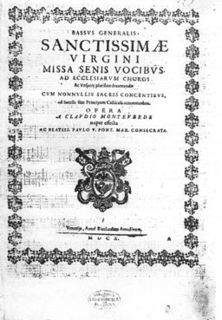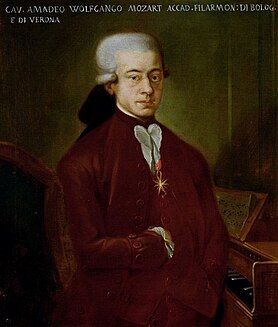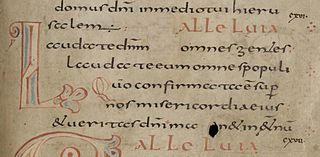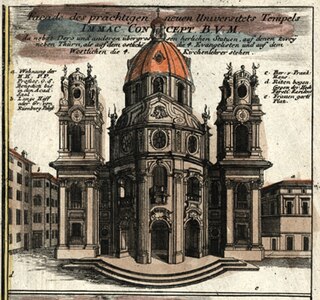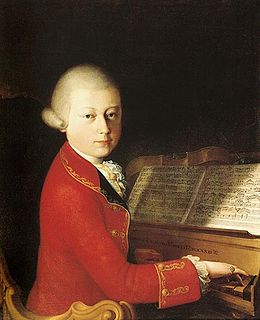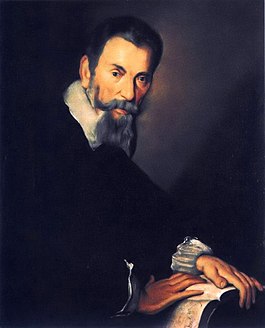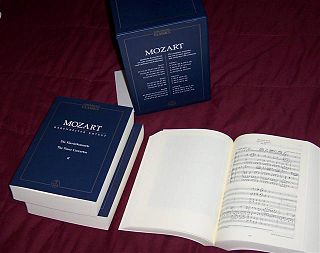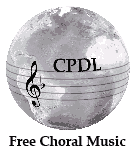| Vesperae solennes de confessore | |
|---|---|
| Solemn Vespers by W. A. Mozart | |
 Salzburg Cathedral, for which the music was composed | |
| Catalogue | K. 339 |
| Text |
|
| Language | Latin |
| Composed | 1780: Salzburg |
| Movements | 6 |
| Vocal | SATB choir and soloists |
| Instrumental |
|
Vesperae solennes de confessore (Solemn Vespers for a Confessor), K. 339, is a sacred choral composition, written by Wolfgang Amadeus Mozart in 1780. It is scored for SATB choir and soloists, violin I, violin II, 2 trumpets, 3 trombones colla parte , 2 timpani, and basso continuo (violoncello, double bass, and organ, with optional bassoon obbligato).
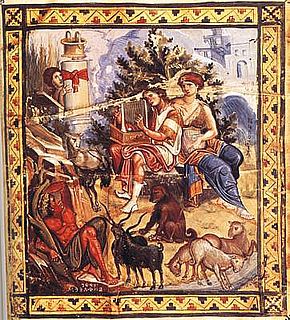
Religious music is music performed or composed for religious use or through religious influence. Ritual music is music, sacred or not, performed or composed for or as ritual.

Wolfgang Amadeus Mozart, baptised as Johannes Chrysostomus Wolfgangus Theophilus Mozart, was a prolific and influential composer of the classical era.
In music, SATB is an initialism for soprano, alto, tenor, bass, defining the voice types required by a chorus or choir to perform a particular musical work. Pieces written for SATB can be sung by choruses of mixed genders, by choirs of men and boys, or by four soloists.
The setting was composed for liturgical use in the Salzburg Cathedral. [1] The title "de confessore" was not Mozart's own, and was added by a later hand to his manuscript. It suggests that the work was intended for vespers held on a specific day on the liturgical calendar of saints ("confessors"); however, the saint in question has not been conclusively established. [2] This was Mozart's final choral work composed for the cathedral. [3]

Salzburg Cathedral is the seventeenth-century Baroque cathedral of the Roman Catholic Archdiocese of Salzburg in the city of Salzburg, Austria, dedicated to Saint Rupert and Saint Vergilius. Saint Rupert founded the church in 774 on the remnants of a Roman town, the cathedral was rebuilt in 1181 after a fire. In the seventeenth century, the cathedral was completely rebuilt in the Baroque style under Prince-Bishop Wolf Dietrich von Raitenau to its present appearance. Salzburg Cathedral still contains the baptismal font in which composer Wolfgang Amadeus Mozart was baptized.

Vespers is a sunset evening prayer service in the Orthodox, Roman Catholic and Eastern Catholic, Anglican, and Lutheran liturgies of the canonical hours. The word comes from the Greek ἑσπέρα ("hespera") and the Latin vesper, meaning "evening". It is also referred to in the Anglican tradition as evening prayer or evensong. The term is also used in some Protestant denominations to describe evening services.

The calendar of saints is a traditional Christian method of organizing a liturgical year by associating each day with one or more saints and referring to the day as the feast day or feast of said saint. The word "feast" in this context does not mean "a large meal, typically a celebratory one", but instead "an annual religious celebration, a day dedicated to a particular saint".
Structurally, it is very similar to Vesperae solennes de Dominica (K. 321), composed in 1779. The setting is divided into 6 movements; as in Dominica, a setting of the Minor Doxology (Gloria Patri) concludes all movements, each recapitulating the opening themes. The first three psalms are scored in a bold, exuberant manner, contrasting with the strict, stile antico counterpoint of the a cappella fourth psalm, [3] and the tranquility of the fifth movement. The Magnificat sees a return to the style of the opening settings.

Vesperae solennes de Dominica, K. 321, is a sacred choral composition, written by Wolfgang Amadeus Mozart in 1779. It is scored for SATB choir and soloists, violin I and II, 2 trumpets, 3 trombones colla parte, 2 timpani, and basso continuo.
Prima pratica refers to early Baroque music which looks more to the style of Palestrina, or the style codified by Gioseffo Zarlino, than to more "modern" styles. It is contrasted with seconda pratica music.. The term prima pratica was first used during the conflict between Giovanni Artusi and Claudio Monteverdi about the new musical style.

In music, counterpoint is the relationship between voices that are harmonically interdependent (polyphony) yet independent in rhythm and contour. It has been most commonly identified in the European classical tradition, strongly developing during the Renaissance and in much of the common practice period, especially in the Baroque. The term originates from the Latin punctus contra punctum meaning "point against point".
- Dixit Dominus (Psalm 110) Allegro vivace, C major, 3/4
- Confitebor tibi Domine (Psalm 111) Allegro, E-flat major, common time
- Beatus vir qui timet Dominum (Psalm 112) Allegro vivace, G major, 3/4
- Laudate pueri Dominum (Psalm 113) Allegro, D minor, cut common time
- Laudate Dominum omnes gentes (Psalm 117) Andante, F major, 6/8
- Mozart departs from the structure of K. 321 in this movement. The earlier setting of Laudate Dominum is a highly melismatic soprano solo, with no choral interlude. In K. 339, the soprano solo is much simpler; the choir quietly enters at the conclusion of the psalm with the Gloria Patri, and the soloist rejoins them at the Amen.
- This movement is well known outside the context of the larger work, and is often performed in isolation. [4]
- Magnificat (Canticle for Vespers) Andante, C major, common time
- —"Et exultavit..." Allegro, C major, common time

